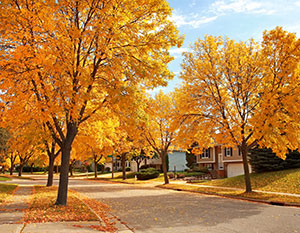Every October in Canada, we lose our grip on summer temperatures and the leaves begin to change colour. It won’t be long before snow flakes are falling and you will be changing the tires on your car. Everyone knows how vicious Canadian winters can be for the brave few who chose to endure it. While most of us are warming up inside by the fire with a cup of hot chocolate, your lawn and gardens are outside suffocating and freezing under the bitterly cold snow and ice that accumulates. The following steps will help you winterize your property to ensure maximum protection and lushness for the spring thaw.

The first step in winterizing your lawn is raking or mowing your lawn to remove leaves. If you are able to, this is also a good time to aerate your lawn to allow oxygen into the soil. Next, it is a good idea to sprinkle top soil down in preparation for the next step: seeding. Chose a seed based on your lawn’s level of sun, and foot traffic. Cut your lawn slightly shorter than usual and spread the seed evenly throughout your lawn. The final step is to water and feed your lawn. Newly seeded grass needs water daily, and the grass feed will act as a fertilizer, reducing the number of weeds you may have in the spring. A common misconception about winterizing grass is that you should cut your lawn prior to snow falling. It is best to leave your lawn slightly longer than usual to ensure deeper roots that can withstand mother nature’s wrath.
When tending to your garden before the first snowfall, the most important thing is to clean. Remove any dead foliage that may be a cause of disease to other plants in your garden. Cutting plants down and removing debris will give your neighbours the impression that your garden is cared for all winter long, and will reduce the amount of work needed in the spring. Be sure to remove any invasive plants and weeds as well. Once everything is cleaned up, it is a good idea to lay down compost that will provide your plants with nutrients over the winter and will turn into soil in the spring. Once you have laid a layer of compost, spread mulch evenly over your garden bed. It is best to do this once the ground is already fully or partially frozen. This will provide an insulator to the roots of your plants, protecting them from rapid freezing and thaws. Late autumn is a particularly dry time so it is a good idea to water your evergreens on a day that is above freezing.
Winter is a harsh reality Canadians live with for upwards of 5 months every year. While some damage can’t be avoided, following these steps will help protect your property from ice, snow, and biting cold temperatures. Your spring-cleaning to-do list will thank you!

